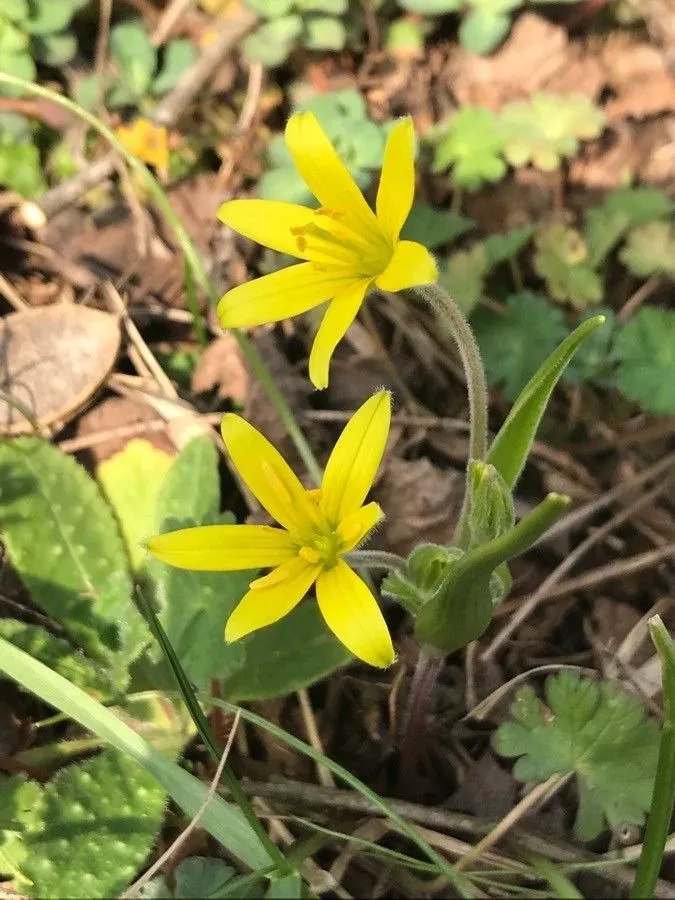
Author: (M.Bieb.) Sweet
Bibliography: Hort. Brit.: 418 (1826)
Year: 1826
Status: accepted
Rank: species
Genus: Gagea
Vegetable: False
Observations: Europe, Medit. to S. Iran
The Hairy Star of Bethlehem, scientifically known as Gagea villosa, is a captivating species within the family Liliaceae. Its mesmerizing presence can be found spanning across Europe, the Mediterranean region, and extending to southern Iran, making it a plant of considerable geographic distribution.
Acknowledged in the bibliography as recorded in 1826 within Hortus Britannicus, this species was aptly described by Sweet, furthering the understanding of its botanical characteristics. The involvement of such documentation highlights the longstanding interest and study of Gagea villosa in the horticultural community.
One of the most distinctive features of the Hairy Star of Bethlehem is its velvety, hair-covered leaves, which give rise to its common name. This protective fur-like coating not only contributes to its unique aesthetic but also serves as an adaptation to its diverse habitats. The plant typically flourishes in open fields and meadows, where it receives abundant sunlight and can thrive in well-drained soil conditions.
Gagea villosa showcases a striking array of star-shaped flowers, usually yellow, which bloom in the early spring. These flowers are often observed as a herald of the changing seasons, providing an early burst of color and life to the landscapes it inhabits. The flowering heads are points of ecological interaction, attracting various pollinators that contribute to the pollination and reproduction of the species.
Despite its delicate appearance, the Hairy Star of Bethlehem is a resilient plant, well-adapted to the often harsh conditions of its wide-ranging native habitats. This includes tolerance to climatic variations and resilience in the face of competition from other flora.
Cultivating Gagea villosa can be a rewarding endeavor for gardeners and plant enthusiasts alike. It requires minimal maintenance once established and can provide a lovely groundcover while adding a touch of wild elegance to cultivated spaces.
In summary, the Hairy Star of Bethlehem, Gagea villosa, stands as a testament to the beauty and durability of nature. With its rich botanical history, remarkable adaptability, and striking floral displays, it continues to be a subject of admiration and study within the botanical realms.
Deu: acker-gelbstern
Dan: ager-guldstjerne
Swe: luddvårlök
En: Hairy star of Bethlehem, Field Star-of-Bethlehem
Da: Ager-guldstjerne
Nl: Akkergeelster
Fr: Gagée des champs, Gagée velue
De: Acker-Gelbstern, Acker Goldstern
It: Cipollaccio dei campi
Sv: Luddvårlök
: Hairy star of bethlehem
Taken Jun 8, 2022 by zh jero (cc-by-sa)
Taken Mar 5, 2020 by Fernando Cabrero (cc-by-sa)
Taken Mar 30, 2018 by Núria Comas (cc-by-sa)
Taken Mar 6, 2020 by francoise sureau (cc-by-sa)
Taken Mar 2, 2021 by Zioivan Beirut (cc-by-sa)
© copyright of the Board of Trustees of the Royal Botanic Gardens, Kew.
Taken Apr 3, 2022 by Sandor Samu (cc-by-sa)
Taken Mar 3, 2021 by Lisa T (cc-by-sa)
Taken Mar 14, 2015 by Tela Botanica − Martin Legaye (cc-by-sa)
Taken May 3, 2021 by B Galgia (cc-by-sa)
Taken Mar 2, 2021 by Zioivan Beirut (cc-by-sa)
Taken Feb 27, 2016 by Tela Botanica − Yoan MARTIN (cc-by-sa)
Taken Feb 27, 2016 by Tela Botanica − Yoan MARTIN (cc-by-sa)
Taken Feb 27, 2016 by Tela Botanica − Yoan MARTIN (cc-by-sa)
Taken Feb 27, 2016 by Tela Botanica − Yoan MARTIN (cc-by-sa)
Taken Mar 2, 2021 by Zioivan Beirut (cc-by-sa)
Taken Apr 15, 2006 by Photoflora – Benoit BOCK (©)
Taken Mar 15, 2009 by Photoflora – Benoit BOCK (©)
Taken May 3, 2021 by B Galgia (cc-by-sa)
Taken Mar 9, 2015 by Tela Botanica − Jean-Claude CALAIS (cc-by-sa)
Taken Apr 10, 2022 by Petr Harant (cc-by-sa)
Taken Mar 14, 2015 by Tela Botanica − Martin Legaye (cc-by-sa)
Growth habit: Forb/herb
Ph maximum: 7.5
Ph minimum: 7.0
Light: 6
Atmospheric humidity: 4
Bloom months: [‘mar’, ‘apr’]
Soil nutriments: 5
Family: Myrtaceae Author: (F.Muell.) K.D.Hill & L.A.S.Johnson Bibliography: Telopea 6: 402 (1995) Year: 1995 Status:…
Family: Rubiaceae Author: Pierre ex A.Froehner Bibliography: Notizbl. Bot. Gart. Berlin-Dahlem 1: 237 (1897) Year:…
Family: Sapindaceae Author: Koidz. Bibliography: J. Coll. Sci. Imp. Univ. Tokyo 32(1): 38 (1911) Year:…
Family: Asteraceae Author: A.Gray Bibliography: Pacif. Railr. Rep.: 107 (1857) Year: 1857 Status: accepted Rank:…
Family: Fabaceae Author: Medik. Bibliography: Vorles. Churpfälz. Phys.-Ökon. Ges. 2: 398 (1787) Year: 1787 Status:…
Family: Aspleniaceae Author: (Cav.) Alston Bibliography: Bull. Misc. Inform. Kew 1932: 309 (1932) Year: 1932…